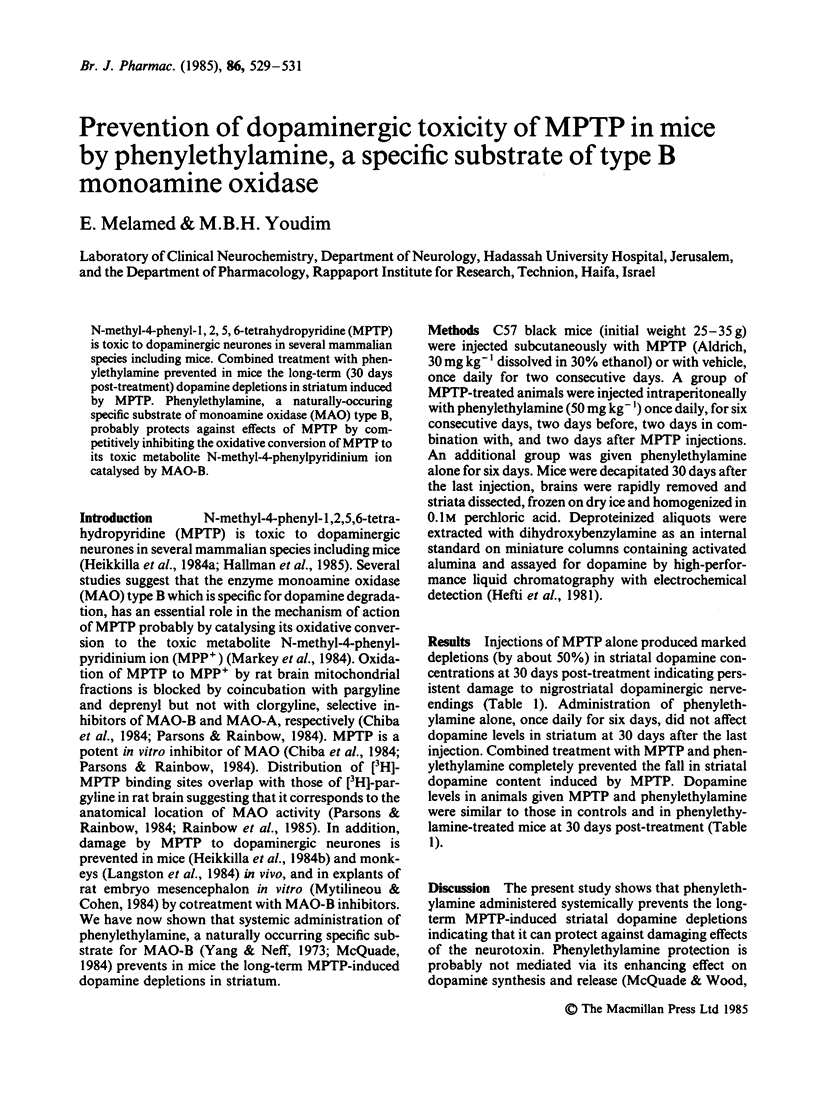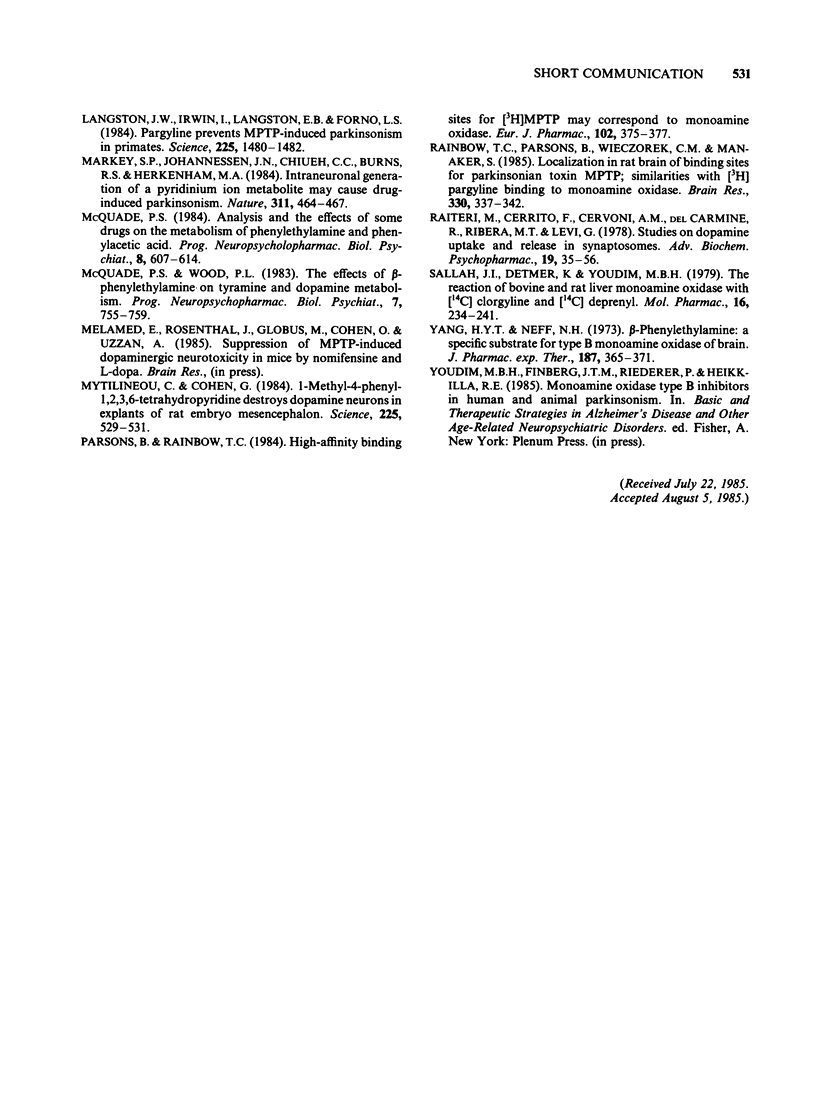Abstract
N-methyl-4-phenyl-1,2,5,6-tetrahydropyridine (MPTP) is toxic to dopaminergic neurones in several mammalian species including mice. Combined treatment with phenylethylamine prevented in mice the long-term (30 days post-treatment) dopamine depletions in striatum induced by MPTP. Phenylethylamine, a naturally-occurring specific substrate of monoamine oxidase (MAO) type B, probably protects against effects of MPTP by competitively inhibiting the oxidative conversion of MPTP to its toxic metabolite N-methyl-4-phenylpyridinium ion catalysed by MAO-B.
Full text
PDF


Selected References
These references are in PubMed. This may not be the complete list of references from this article.
- Antelman S. M., Edwards D. J., Lin M. Phenylethylamine: evidence for a direct, postsynaptic dopamine-receptor stimulating action. Brain Res. 1977 May 27;127(2):317–322. doi: 10.1016/0006-8993(77)90548-0. [DOI] [PubMed] [Google Scholar]
- Boyce S., Kelly E., Reavill C., Jenner P., Marsden C. D. Repeated administration of N-methyl-4-phenyl 1,2,5,6-tetrahydropyridine to rats is not toxic to striatal dopamine neurones. Biochem Pharmacol. 1984 Jun 1;33(11):1747–1752. doi: 10.1016/0006-2952(84)90344-7. [DOI] [PubMed] [Google Scholar]
- Chiba K., Trevor A., Castagnoli N., Jr Metabolism of the neurotoxic tertiary amine, MPTP, by brain monoamine oxidase. Biochem Biophys Res Commun. 1984 Apr 30;120(2):574–578. doi: 10.1016/0006-291x(84)91293-2. [DOI] [PubMed] [Google Scholar]
- Chiueh C. C., Markey S. P., Burns R. S., Johannessen J. N., Pert A., Kopin I. J. Neurochemical and behavioral effects of systemic and intranigral administration of N-methyl-4-phenyl-1,2,3,6-tetrahydropyridine in the rat. Eur J Pharmacol. 1984 Apr 20;100(2):189–194. doi: 10.1016/0014-2999(84)90221-8. [DOI] [PubMed] [Google Scholar]
- Hallman H., Lange J., Olson L., Strömberg I., Jonsson G. Neurochemical and histochemical characterization of neurotoxic effects of 1-methyl-4-phenyl-1,2,3,6-tetrahydropyridine on brain catecholamine neurones in the mouse. J Neurochem. 1985 Jan;44(1):117–127. doi: 10.1111/j.1471-4159.1985.tb07120.x. [DOI] [PubMed] [Google Scholar]
- Hefti F., Melamed E., Wurtman R. J. The site of dopamine formation in rat striatum after L-dopa administration. J Pharmacol Exp Ther. 1981 Apr;217(1):189–197. [PubMed] [Google Scholar]
- Heikkila R. E., Hess A., Duvoisin R. C. Dopaminergic neurotoxicity of 1-methyl-4-phenyl-1,2,5,6-tetrahydropyridine in mice. Science. 1984 Jun 29;224(4656):1451–1453. doi: 10.1126/science.6610213. [DOI] [PubMed] [Google Scholar]
- Heikkila R. E., Manzino L., Cabbat F. S., Duvoisin R. C. Protection against the dopaminergic neurotoxicity of 1-methyl-4-phenyl-1,2,5,6-tetrahydropyridine by monoamine oxidase inhibitors. Nature. 1984 Oct 4;311(5985):467–469. doi: 10.1038/311467a0. [DOI] [PubMed] [Google Scholar]
- Langston J. W., Irwin I., Langston E. B., Forno L. S. Pargyline prevents MPTP-induced parkinsonism in primates. Science. 1984 Sep 28;225(4669):1480–1482. doi: 10.1126/science.6332378. [DOI] [PubMed] [Google Scholar]
- Markey S. P., Johannessen J. N., Chiueh C. C., Burns R. S., Herkenham M. A. Intraneuronal generation of a pyridinium metabolite may cause drug-induced parkinsonism. Nature. 1984 Oct 4;311(5985):464–467. doi: 10.1038/311464a0. [DOI] [PubMed] [Google Scholar]
- McQuade P. S. Analysis and the effects of some drugs on the metabolism of phenylethylamine and phenylacetic acid. Prog Neuropsychopharmacol Biol Psychiatry. 1984;8(4-6):607–614. doi: 10.1016/0278-5846(84)90022-8. [DOI] [PubMed] [Google Scholar]
- McQuade P. S., Wood P. L. The effects of beta-phenylethylamine on tyramine and dopamine metabolism. Prog Neuropsychopharmacol Biol Psychiatry. 1983;7(4-6):755–759. doi: 10.1016/0278-5846(83)90060-x. [DOI] [PubMed] [Google Scholar]
- Mytilineou C., Cohen G. 1-methyl-4-phenyl-1,2,3,6-tetrahydropyridine destroys dopamine neurons in explants of rat embryo mesencephalon. Science. 1984 Aug 3;225(4661):529–531. doi: 10.1126/science.6610939. [DOI] [PubMed] [Google Scholar]
- Parsons B., Rainbow T. C. High-affinity binding sites for [3H]MPTP may correspond to monamine oxidase. Eur J Pharmacol. 1984 Jul 13;102(2):375–377. doi: 10.1016/0014-2999(84)90274-7. [DOI] [PubMed] [Google Scholar]
- Rainbow T. C., Parsons B., Wieczorek C. M., Manaker S. Localization in rat brain of binding sites for parkinsonian toxin MPTP: similarities with [3H]pargyline binding to monoamine oxidase. Brain Res. 1985 Mar 25;330(2):337–342. doi: 10.1016/0006-8993(85)90694-8. [DOI] [PubMed] [Google Scholar]
- Raiteri M., Cerrito F., Cervoni A. M., del Carmine R., Ribera M. T., Levi G. Studies on dopamine uptake and release in synaptosomes. Adv Biochem Psychopharmacol. 1978;19:35–56. [PubMed] [Google Scholar]
- Salach J. I., Detmer K., Youdim M. B. The reaction of bovine and rat liver monoamine oxidase with [14C]-clorgyline and [14C]-deprenyl. Mol Pharmacol. 1979 Jul;16(1):234–241. [PubMed] [Google Scholar]
- Yang H. Y., Neff N. H. Beta-phenylethylamine: a specific substrate for type B monoamine oxidase of brain. J Pharmacol Exp Ther. 1973 Nov;187(2):365–371. [PubMed] [Google Scholar]


